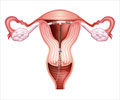A new Virginia Commonwealth University study has found that intrauterine devices (IUD) are safe and effective for birth control in a population of high-risk women.
Women who are at high risk for both sexually transmitted infections and pregnancy have been classified as poor candidates for this method of contraception.The IUD is the most common form of reversible birth control used by women. While IUDs offer a high level of long-term contraceptive efficacy, they have been associated with health risks, including pelvic inflammatory disease and upper genital tract infections.
As part of the study, Catherine A. Matthews and colleagues conducted a medical chart review of approximately 200 women who had IUDs inserted between 2000 and 2005 and compared the efficacy and complication rates of the Paragard IUD and Mirena intrauterine system (IUS).
Both are T-shaped devices are placed in the uterus to prevent pregnancy, however, the Mirena IUS releases a hormone.
A third of women who received an IUD had a history of STD prior to insertion. Additionally, 32 percent of women had a history of other gynaecological infections such as bacterial vaginosis, and almost half were unmarried.
The study found that IUDs were acceptable and not associated with a significant increase in occurrence of gynaecologic infections in women who were at high risk for both sexually transmitted infections and pregnancy.
Advertisement
“We once thought that IUDs could only be used in married, monogamous women because of a perceived increase in the risk of pelvic infections,” she added.
Advertisement
Source-ANI
SRM/J








